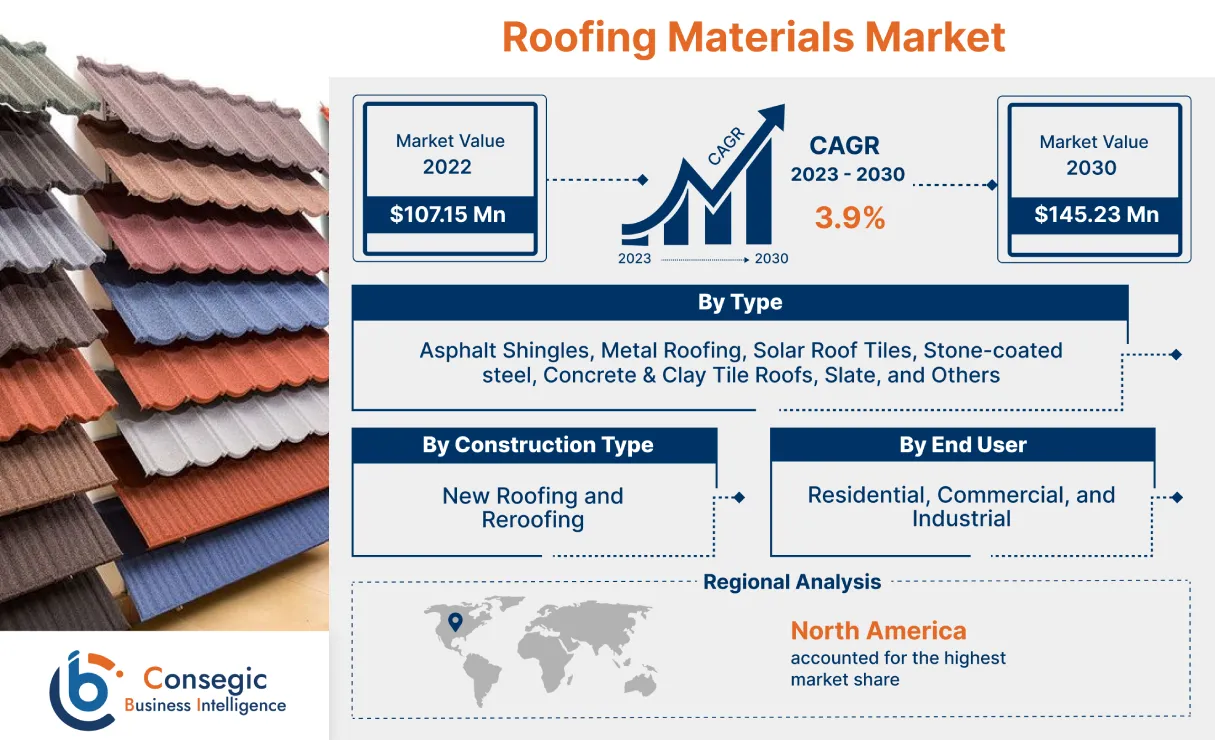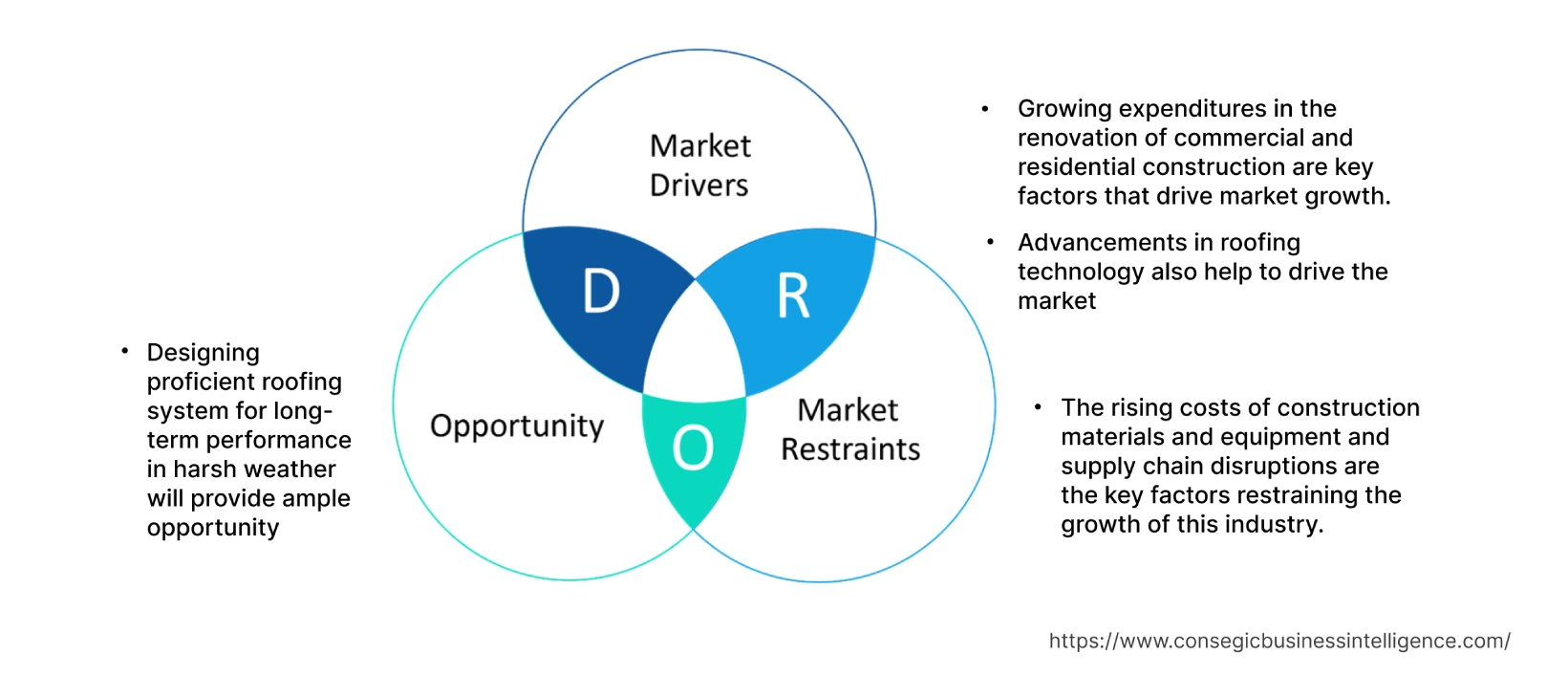- Summary
- Table Of Content
- Methodology
Roofing Materials Market Size :
Consegic Business Intelligence analyzes that the Roofing Materials Market size is growing with a CAGR of 3.9% during the forecast period (2023-2030), and the market is projected to be valued at USD 145.23 Million by 2030 from USD 107.15 Million in 2022.
Roofing Materials Market Scope & Overview:
Roofing materials are the materials used to cover the top of a building to protect it from the elements. The roofing material is specifically selected to protect against exterior elements including rain, direct sunlight, and snow. They are chosen based on factors such as durability, cost, and aesthetic appeal. The cost of roof renovations can vary extensively. Some of the factors such as the type of roofing material, the cost of labor, and the size & shape of the roof vary the cost of roof replacement. Numerous types of roofing materials are commercialized in the market namely asphalt shingles, metal roofing, solar roof tiles, stone-coated steel, concrete & clay tile roofs, and slate, among others.
Roofing Materials Market Insights :
Key Drivers :
Growing expenditures in the renovation of commercial and residential construction are key factors that drive market growth
A building's roofing material provides shelter from the natural elements, such as rain, snow, wind, and sun. It also helps to insulate the building and keep it cool in the summer and warm in the winter. The roofing industry has seen significant growth in the last couple of years. Residential construction expenditure contributes to the revenue development for the roofing material industry globally. The demand for residential construction has increased as the housing market expanded in the last five years. There are around 109,331 roofing contractor businesses in the U.S. as of 2022, showing a 1.8% rise from 2021. Several factors such as growing per capita disposable income and low interest rates have made home ownership affordable for consumers growing the requirement for new roofs. Thus, rising spending in the renovation of commercial and residential construction are key factor that drives market growth.
Advancements in roofing technology also help to drive the market
Advancements in roofing technology have significantly driven market growth, fueled by the demand for sustainable, energy-efficient, and long-lasting solutions. Key innovations include green roofs, which provide natural insulation, reduce energy consumption, and mitigate urban heat island effects, and cool roofs, designed to reflect sunlight and reduce heat absorption, lowering cooling costs. Additionally, advanced roofing materials such as polymer-modified bitumen, TPO, and EPDM offer enhanced durability, UV resistance, and weatherproofing.
The rise of solar-integrated roofing systems is also notable, allowing for energy generation alongside traditional roofing functions. Furthermore, smart roofing technologies featuring sensors that monitor environmental conditions and optimize energy use are gaining popularity, increasing efficiency and longevity. These advancements not only improve the sustainability and performance of buildings but also contribute to long-term cost savings and reduced environmental impact, positioning advanced roofing technologies as key drivers of the roofing materials market growth.
Key Restraints :
The rising costs of construction materials and equipment and supply chain disruptions are the key factors restraining the growth of this industry
The growth of the roofing market is being restrained by the rising costs of construction materials, equipment, and ongoing supply chain disruptions. Roofing materials, essential for protecting buildings from elements like rain, snow, sunlight, wind, and extreme temperatures, have seen significant price increases in recent years. These escalating costs of construction materials and equipment, coupled with delays and shortages in the supply chain, are major factors hindering market expansion. As a result, the overall affordability of roofing solutions is being impacted, leading to challenges for both manufacturers and consumers and slowing the growth of the industry.
Future Opportunities :
Designing proficient roofing system for long-term performance in harsh weather will provide ample opportunity
Designing roofing systems for long-term performance in harsh weather conditions presents significant market opportunities. Proficient roofing solutions can reduce maintenance costs, enhance energy efficiency, and improve indoor air quality. Innovations such as roof-integrated solar panels are gaining traction, as they not only provide weather resilience but also offer additional energy-generation benefits. For instance, GAF Energy's launch of Solaria panels in 2020, which are 16% more powerful than conventional solar-integrated roofs, allows homeowners to install more solar capacity in the same space. These advancements offer substantial energy savings and make roofs more functional, aligning with the growing demand for sustainable, cost-effective solutions. Such innovations are expected to drive market growth by improving both the durability and functionality of roofing systems.
Global Roofing Materials Market Report Insights :
| Report Attributes | Report Details |
| Study Timeline | 2017-2030 |
| Market Size in 2030 | USD 145.23 Million |
| CAGR (2023-2030) | 3.9% |
| By Type | Asphalt Shingles, Metal Roofing, Solar Roof Tiles, Stone-coated steel, Concrete & Clay Tile Roofs, Slate, and Others |
| By Construction Type | New Roofing and Reroofing |
| By End-User | Residential, Commercial, and Industrial |
| By Region | North America, Europe, Asia-Pacific, Latin America, and Middle East & Africa |
| Key Players | GAF Materials Corporation, Atlas Roofing Corporation, Owens Corning, TAMKO Building Products, Inc., Carlisle Companies Inc., Metal Sales Manufacturing Corporation, Wienerberger AG, CertainTeed Corporation, Boral Roofing, and IKO Industries Ltd. |
| Geographies Covered | |
| North America | U.S. Canada Mexico |
| Europe | U.K. Germany France Spain Italy Russia Benelux Rest of Europe |
| APAC | China South Korea Japan India Australia ASEAN Rest of Asia-Pacific |
| Middle East and Africa | GCC Turkey South Africa Rest of MEA |
| LATAM | Brazil Argentina Chile Rest of LATAM |
| Report Coverage | Revenue Forecast, Competitive Landscape, Growth Factors, Restraint or Challenges, Opportunities, Environment & Regulatory Landscape, PESTLE Analysis, PORTER Analysis, Key Technology Landscape, Value Chain Analysis, Cost Analysis, and Regional Trends & Forecast |
Roofing Materials Market Segmental Analysis :
By Type :
The roofing market is segmented into asphalt shingles, metal roofing, solar roof tiles, stone-coated steel, concrete & clay tile roofs, slate, and others. In 2022, the asphalt shingles segment dominated the market due to their widespread use, cost-effectiveness, and ease of installation. Made from a fiberglass mat coated with asphalt and mineral granules, asphalt shingles offer good durability, weather resistance, and are available in a variety of colors and styles. They are particularly popular in residential construction due to their affordability, though they may fade over time and require periodic maintenance.
Metal roofing, which includes materials like aluminum, steel, copper, and zinc, is expected to grow at the fastest CAGR during the forecast period. Metal roofs are known for their superior durability, lightweight nature, and ability to withstand extreme weather conditions such as high winds, heavy rain, and snow. They also offer excellent fire resistance, reflectivity, and energy efficiency, helping reduce cooling costs in warm climates. Additionally, metal roofing systems are highly recyclable, making them a sustainable choice for eco-conscious consumers. Other materials like solar roof tiles and stone-coated steel are gaining traction for their energy efficiency, durability, and aesthetic appeal, contributing to the diversification of the roofing market.
By Construction Type :
The roofing market is divided into two segments: new roofing and reroofing. In 2022, the reroofing segment held the largest market share. Reroofing involves replacing the top layer of roofing material, typically when the existing roof shows signs of damage, such as leaks, missing shingles, or curling edges. This segment is primarily driven by the increasing demand for the renovation of old buildings, as homeowners and businesses seek to restore and maintain their properties. Reroofing is often a cost-effective solution compared to replacing the entire roofing system, making it a popular choice for building owners looking to extend the life of their structures.
The new roofing segment is expected to grow at the fastest CAGR during the forecast period. This growth is largely fueled by urbanization and industrialization across both developed and developing regions, which is driving the construction of new residential, commercial, and industrial buildings. The rise in infrastructure development and population growth in urban areas is leading to a higher demand for new roofing installations. Additionally, increasing awareness of energy-efficient and sustainable roofing options is also contributing to the segment's expansion.
By End-User :
The roofing market is segmented into residential, commercial, and industrial end-users. In 2022, the residential segment held the largest market share at 41.35% and is expected to grow at the fastest CAGR over the forecast period. This growth is driven by increased policy and institutional support for home construction, particularly in developing economies. The demand for residential roofing is fueled by both replacement roofing, driven by the aging of roofs and weather-related events, as well as new home construction. Factors such as rising populations, urbanization, and the growing preference for single-family homes contribute to the increasing demand for residential roofing materials. Additionally, the expansion of affordable housing projects and the trend toward energy-efficient and sustainable roofing solutions are further supporting growth in this segment. The residential sector is expected to remain the dominant driver in the roofing materials market due to these factors.
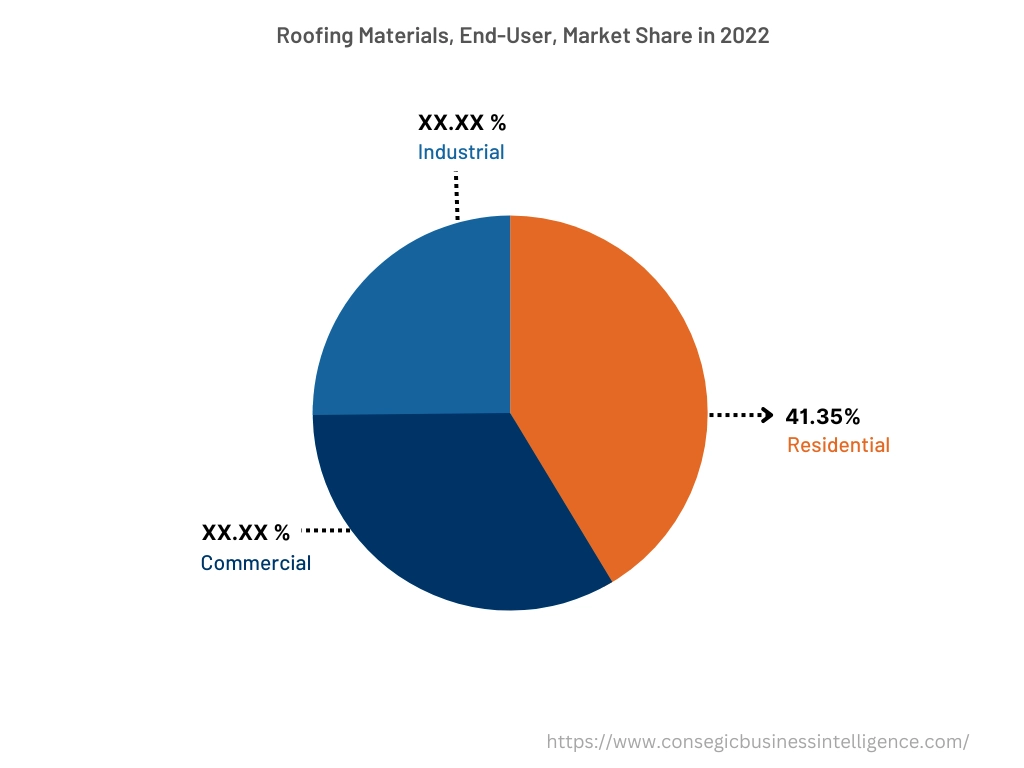
By Region :
The regional segment includes North America, Europe, Asia Pacific, Middle East and Africa, and Latin America.
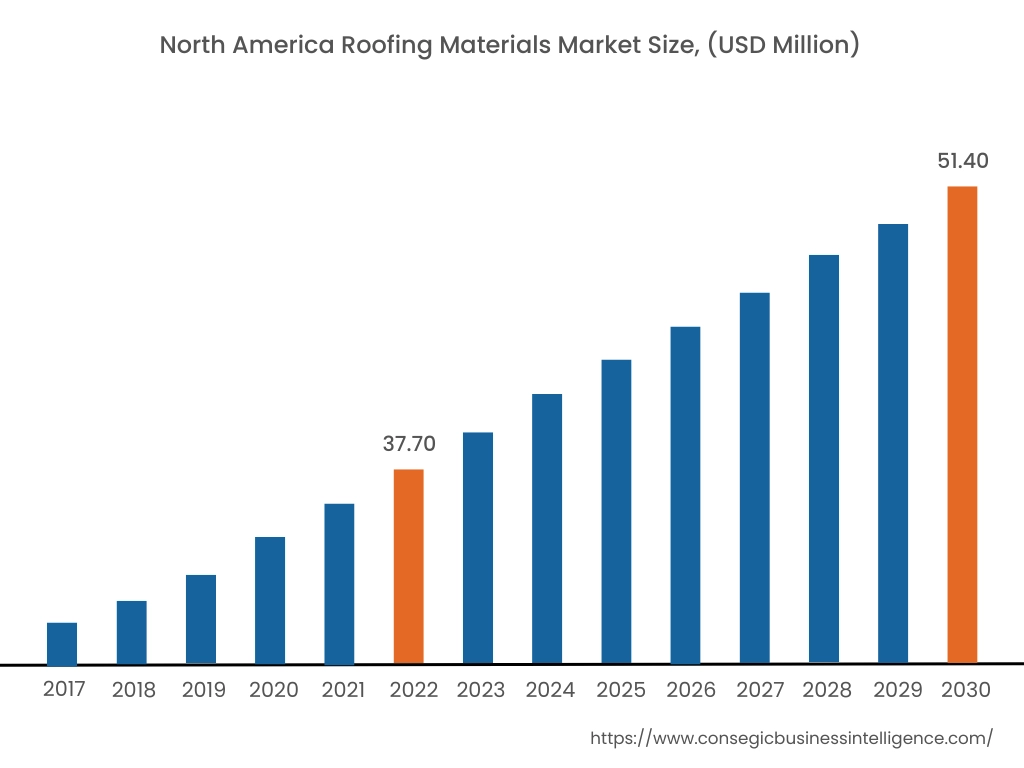
In 2022, North America accounted for the largest market share of 35.18%, valued at USD 37.70 million, and is expected to grow to USD 51.40 million by 2030. This dominance is driven by the high demand for roof replacements, which make up over 90% of the market, particularly in the U.S. and Canada. The region benefits from substantial government infrastructure expenditure aimed at supporting both residential and commercial construction projects. This includes funding for public and private developments, including housing, retail, and industrial projects. Additionally, the U.S. roofing industry is well-established, with around 81,175 roofing contractor businesses in 2022, reflecting a steady increase of 1.5% from the previous year. With the ongoing emphasis on home renovations, energy-efficient roofing solutions, and resilient infrastructure, North America is poised to maintain its leadership in the roofing market.
The Asia Pacific region is forecast to experience the fastest growth, with a projected CAGR of 4.3% during the forecast period. This growth is primarily attributed to rapid urbanization, increasing roofing material demand, and expansion of both new construction and renovation activities. Governments across the region, particularly in India, China, and Japan, are actively promoting large-scale infrastructure projects, with significant investments in residential, commercial, and industrial buildings. Countries like India are seeing a surge in affordable housing projects, and China continues to witness large-scale urban expansion. The growing middle class and the rise in disposable income are also pushing the demand for high-quality, energy-efficient roofing materials in these countries. Furthermore, the shift toward sustainable building practices and roofing innovations such as solar roofs and green roofs is contributing to the region’s rapid growth, making it a key area of opportunity in the global roofing market.
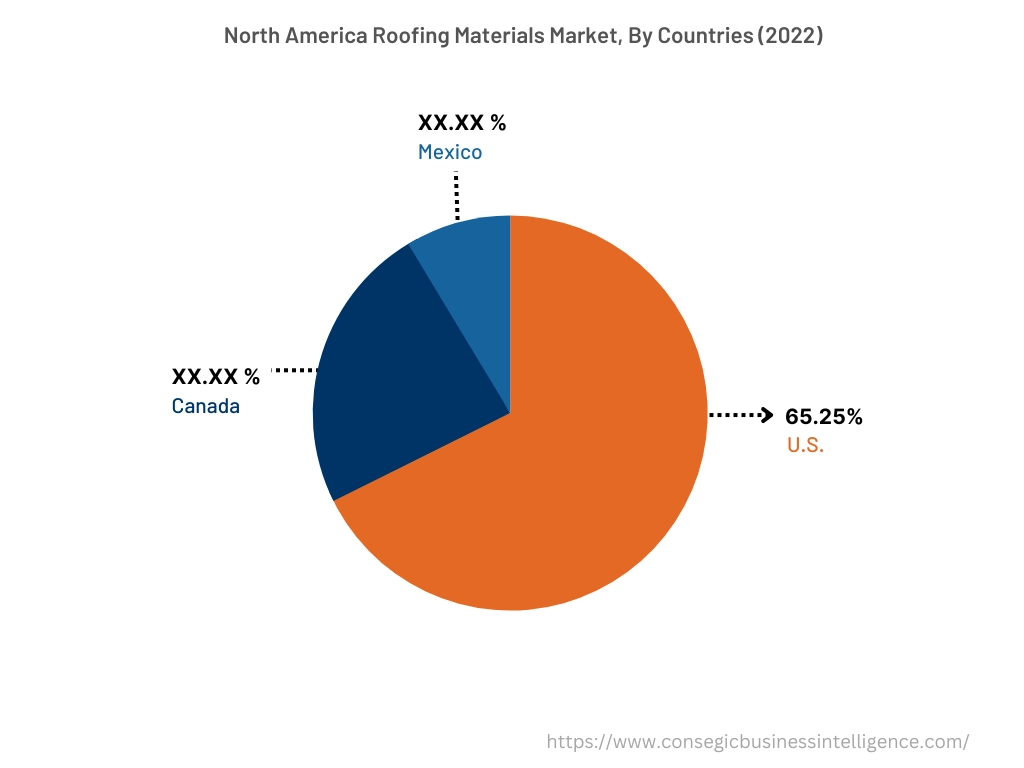
Top Key Players & Market Share Insights:
The roofing materials market is highly competitive, with numerous large players and numerous small and medium-sized enterprises. These companies have strong research and development capabilities and a strong presence in the market through their extensive product portfolios and distribution networks. The market is characterized by intense competition, with companies focusing on expanding their product offerings and increasing their market share through mergers, acquisitions, and partnerships. The key players in the market include-
- GAF Materials Corporation
- Atlas Roofing Corporation
- CertainTeed Corporation
- Boral Roofing
- IKO Industries Ltd.
- Owens Corning
- TAMKO Building Products, Inc.
- Carlisle Companies Inc.
- Metal Sales Manufacturing Corporation
- Wienerberger AG
Recent Industry Developments :
- In February 2022, Johns Manville, launched two new products namely DynaSet 1K and 1-Part PermaFlash for bituminous roofing systems to help increase productivity on the roof.
- In February 2022, Carlisle Companies Incorporated announced the acquisition of MBTechnology, Inc., a manufacturer of energy-efficient, styrene-butadiene-styrene modified bitumen roofing and underlayment systems for residential and commercial applications. The acquisition will expand the company's presence throughout the building envelope and continue to provide its customers with energy-efficient solutions.
Key Questions Answered in the Report
What was the market size of the roofing materials market in 2022? +
In 2022, the market size of roofing materials was USD 107.15 million.
What will be the potential market valuation for the roofing materials market by 2030? +
In 2030, the market size of roofing materials is expected to reach USD 145.23 million.
What are the key factors driving the growth of the roofing materials market? +
Growing expenditures in the renovation of commercial and residential construction is fostering market growth.
What is the dominant segment in the roofing materials market by type? +
In 2022, the asphalt shingles segment accounted for the highest market share in the overall roofing materials market.
Based on current market trends and future predictions, which geographical region will have the fastest impact on the roofing materials market's growth in the coming years? +
Asia Pacific is expected to be the fastest-growing region in the market during the forecast period.
